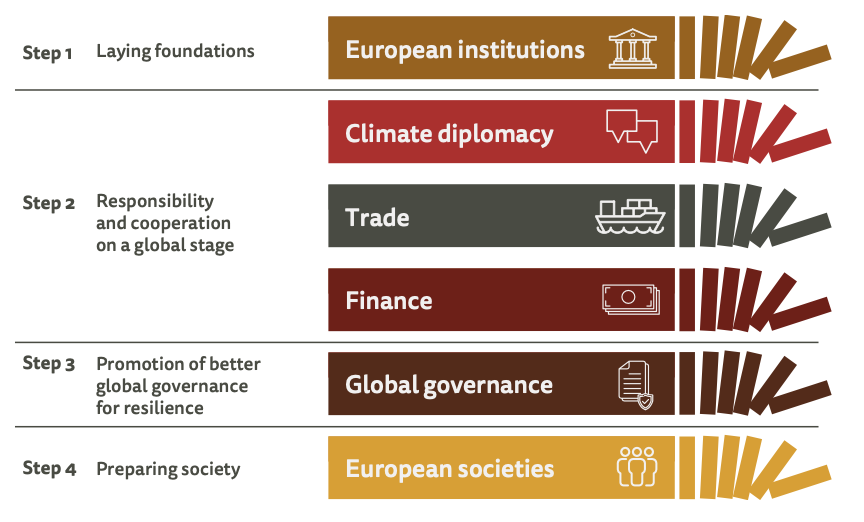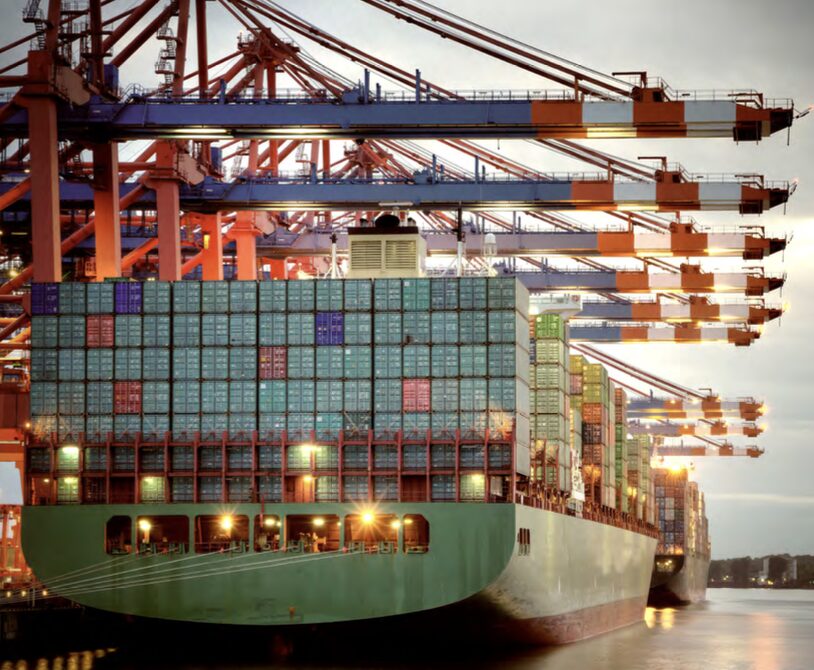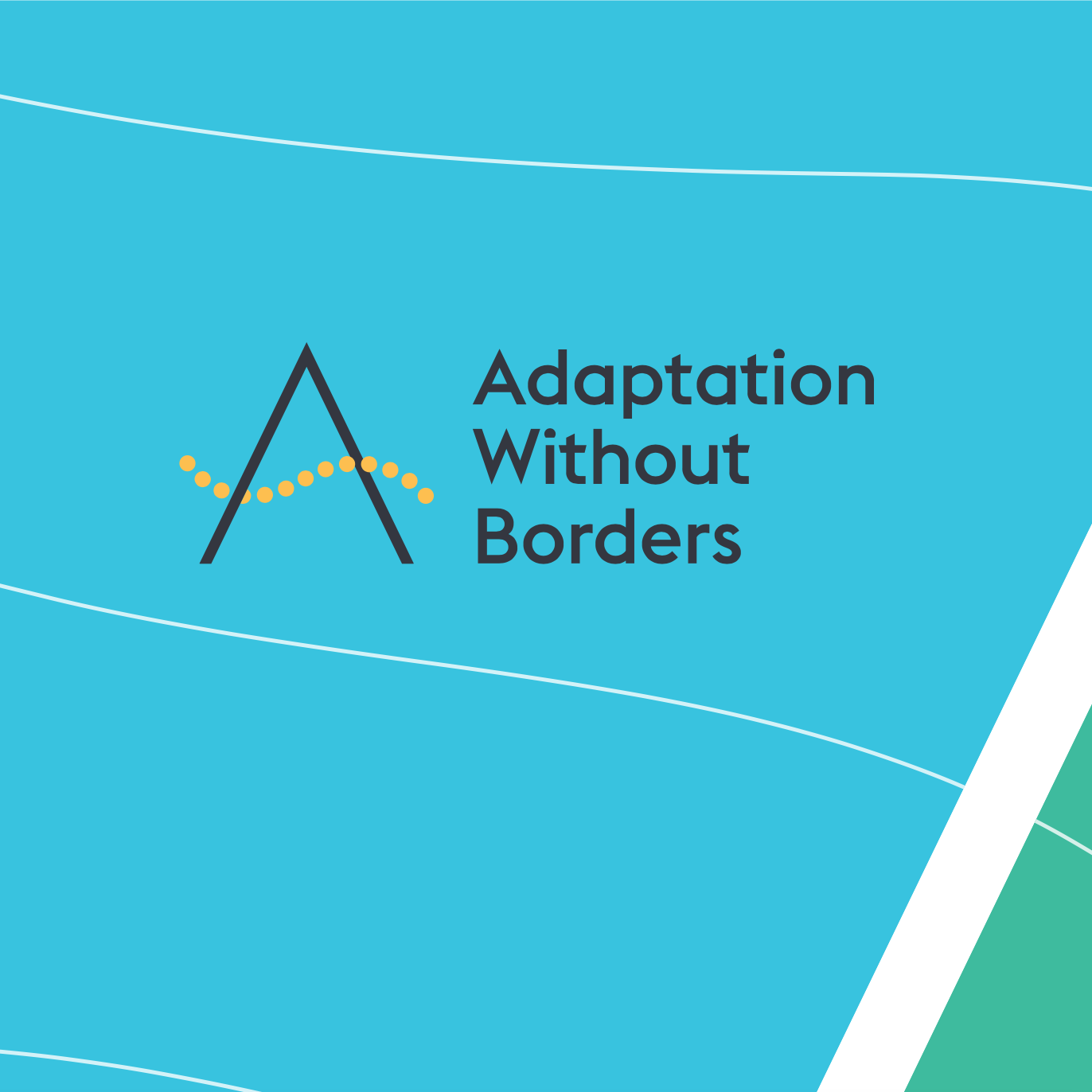Cascading climate risks: strategic recommendations for European resilience

Introduction
Direct climate change impacts such as increasing heatwaves, floods and wildfires pose a serious risk to European societies. Impacts beyond Europe’s borders, in countries with less capacity to prepare, respond and adapt, will be even greater. ‘Cascading climate risks’ connect Europe with other vulnerable places, as climate hazards in remote locations create knock-on impacts that spread across borders and through systems, affecting European societies and economies.
Cascading climate risks are, as yet, little understood and seldom assessed or managed. This report therefore recommends how European stakeholders, particularly the EU, should respond across policy domains, scales and systems.
To meet the cascading climate risk challenge, a stepwise approach to implementing the recommendations is needed. This summary suggests how this might proceed, to enable European institutions and policymakers to hardwire consideration of cascading climate risks into policies and processes. It moves from the level of individual understanding, through institutional change, to systemic transformations.
This article is an abridged version of the original report, which can be downloaded from the right-hand column. Please access the original text for more detail, research purposes, full references, or to quote text. You can also explore the Summary for Policymakers.
Methodology
This report describes a set of 21 strategic recommendations on how to build resilience in Europe and globally to cascading climate risks. These recommendations are the result of a process of identifying, testing and refining messages from the research undertaken by project partners during the four years of the CASCADES project.
An initial list of 300 recommendations was identified from more than 50 documents produced by consortium partners. Recommendations were then grouped by policy domains, synthesized and prioritized during several engagement exercises with stakeholders and consortium experts during 2022 and early 2023, including workshops and interviews. The final list of 21 recommendations seeks to combine impactful, realistic near-term priorities with more transformative medium-term actions.
Recommendations are presented in six clusters, each addressing a specific aspect of European resilience. Readers interested in a specific policy field or topic can go directly to the relevant section:
- European institutions (p.18)
- Climate diplomacy (p.24)
- Trade (p.32)
- Finance (p.38)
- Global governance (p.43)
- European societies (p.47)

A stepwise approach to implementing the recommendations (Figure 1, p.3).
For more information about this process, see the Methodology section of the Appendix.
Step 1: Laying foundations
The European Commission must build a European Civil Service fit for the cascading climate risk challenge, increasing the capacity of staff and institutions to understand and manage cascading climate risk.
There are limits to the predictability of cascading climate impacts, but much more can be done to build understanding (Rec 1.1), including identifying the cascades the EU faces and perpetuates, and those that are initiated within its borders. By building cascade identification into risk assessment practices, and taking steps to better map cascading climate risk, the EU can be better prepared to establish risk ownership (Rec 1.2), allocate resources and measure success (Rec 1.3). Eventually, countries will need to develop a ‘whole-of-government’ approach for cascading risk ownership. Wider stakeholders in cascading climate risks, including in the private sector and civil society, will also need to continuously and effectively engage in cascading risk management.
The development of a risk and resilience mindset (Rec 1.4) across EU institutions will have wider benefits for Europe. Cascading risk, including from non-climatic shocks, will become an increasingly common challenge for policymakers in an interconnected and potentially resource-strained world. As an acknowledged risk amplifier, climate change and its effects will play a role in many of these risk cascades. The capability to understand and manage cascading risks will only become more important in years to come.
Step 2: Responsibility and cooperation on a global stage
No country, region or sector can govern cascading climate risks alone; yet cascading climate risks must be better governed if resilience is to be achieved. The EU must therefore effectively deploy climate diplomacy and foreign policy for European resilience to cascades. At the same time, the EU must demonstrate commitment and investment by making trade and financial flows work for resilience, not against it. Through combining direct investments with more just, fair and resilient financial and trade flows, the EU can pull more forcefully in the direction it will need to go.
The EU will need to build its capability to deploy external action for coherence and efficacy. A first step in this will be to meet and exceed adaptation finance commitments (Rec 2.1) combined with increased technical assistance and political engagement with partner countries (Rec 2.3). Recognizing the shared, though not equal risks and opportunities stemming from cascading climate risks, the EU must effectively contribute to the resilience of low- and middle-income countries. This means meeting existing climate finance and official development assistance (ODA) spending commitments, and ambitiously ramping up adaptation support and finance. This is both in the EU’s self-interest, and for the global public good.
It is possible to build resilience with one hand, while undermining it with the other. Inter-service cooperation is therefore needed to improve policy coherence to avoid harm and harness synergies (Rec 2.2). The need to improve policy coherence is relevant not just to development policy, but also wider foreign policy and security actions, and through trade and financial activities. Such an approach would enable the EU to iteratively cooperate, lead and build trust within the international system (Rec 2.4), by demonstrating its firm and ongoing commitment to EU and wider resilience to cascading climate risks.
Trade
If a more strategic approach is taken, trade can both support and benefit from resilience. As a first step towards this, it will be necessary to formulate a trade resilience strategy for Europe (Rec 3.1). Such a strategy would enable a move away from narrow cost reduction/profit maximization motives and towards an approach that supports wider societal objectives and global goods via trade policy. Countries will need to balance investment in long-term, stable trade partnerships with flexibility to maximize resilience to shocks and dynamic responses in a more volatile world of cascading risk. As part of this, the EU would need to expand the scope of the Critical Entities Directive (Rec 3.2), support and facilitate supply chain ‘restructuring’ (Rec 3.3) and improve risk data and disclosure (Rec 3.4).
Finance
Financial institutions and actors need to better understand and manage climate risks which cascade within financial systems. Enhancing cooperation, communication and disclosure (Rec 4.1) and action to reform risk assessment and monitoring approaches (Rec 4.2) will enable cascading climate risk to be priced. This, in turn, will incentivize investments in adaptation and shift the dial on which projects are considered ‘risky’. These changes support proper allocation of funding for climate action and adaptation, bolstering the contribution of private finance and better enabling the EU to mobilize innovative European finance for widespread resilience (Rec 4.3).
Step 3: Promotion of better global governance for resilience
Action by the EU to build its own capabilities on cascading climate risks, and concrete assumption of responsibility and cooperation on the global stage will give the EU much-needed credibility and legitimacy in working to promote better global governance for resilience.
Leadership for effective cascading climate risk management will need to champion global governance that is fit for cascades (Rec 5.1): in essence, multilateral, inclusive, rules-based global governance with the aims of justice, sustainability and resilience. To achieve these aims, the EU would need to support reform of international structures (Rec 5.2) through concerted efforts, strategic vision and persistent diplomacy. Cascading climate risks are shared, though not equally, and their management requires good faith engagement and redoubled commitment to building, rather than diminishing global trust and cooperation. This will come at a price and require compromise on behalf of the EU and its member states; but it is an investment that will rapidly pay dividends.
The EU needs to give climate security a home (Rec 5.3). This will help the Commission to build a collective and cooperative approach to managing climate-related security challenges. Avoiding the securitization of resilience can help to avert the possibility of destabilizing and reactive responses, which are likely to create traps and negative cascading feedback loops for the EU.
Step 4: Preparing society
The role of society in cascade management and response cannot and should not be ignored or treated as an afterthought. Businesses, local governments, civil society organizations and individuals will all be affected by cascading risks. All will play a crucial role in ensuring society’s resilience. Cascading climate impacts have the potential to increase inequality, impact political stability, feed extremism and destabilize societies. Preparedness across society should therefore be a key pillar of the EU’s approach.
In the face of increasing cascading climate risk, the European Commission should proactively work with member states to engage and support wider society (Rec 6.3). Reactive approaches are likely to decrease political capital to effect necessary changes. It will be important to provide technical support to member states in developing resilient local economies and communities (Rec 6.1) and to support member states to reduce social inequality and strengthen cohesion (Rec 6.2).
More details on each individual recommendation can be found in the corresponding chapter.
Final reflections
Cascading climate risks are likely to transform international relations and human experience as the planet warms. Decision-makers now have the opportunity to influence this transformation. By examining the threads of cascading climate risk, which run throughout complex global systems, the EU and other global actors can better understand the fabric of our current system. This understanding will help them to weave a more resilient social and economic fabric for the future.




(0) Comments
There is no content